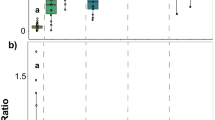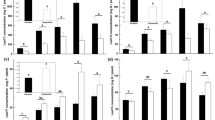Summary
The carbon to nitrogen balance theory was examined for a legume, Lotus corniculatus L., which allocates carbon to nitrogen fixation. N-fixation can influence the ratio of carbon to nitrogen in legumes by providing nitrogen in nutrient-poor habitats, and by consuming carbon for support of symbiotic N-fixation. L. corniculatus clones (genotypes) were grown under two levels of nitrogen fertilization: a treatment which suppressed nodulation with fertilization and a treatment which received no additional fertilization. These plants relied solely on symbiotic N-fixation. Plants which supported symbionts had lower biomass and lower tannin concentrations than fertilized plants; this appears to be a result of the large carbon demand on N-fixation. Plants supporting symbionts often had relatively lower protein concentrations than fertilized plants. Cyanide concentration was influenced by plant genotype but not by nitrogen source. Although symbiotic N-fixing plants were smaller, they had three times the reproductive output of fertilized plants.
Similar content being viewed by others
References
Barta AL (1979) Effect of nitrogen supply of photosynthate partitioning, root carbohydrate accumulation and acetylene reduction in birds foot trefoil. Crop Sci 19:715–718
Bethlenfalvay GJ, Abu-Shakra SS, Phillips DA (1978) Interdependence of nitrogen nutrition and photosynthesis in Pisum sativum. Physiol Plant 42:119–123
Briggs MA, Schultz JC (1990) Chemical defense production in Lotus corniculatus L. II. Trade-offs among growth, reproduction and defense. Oecologia 83:32–37
Bryant JP, Chapin FS, Klein DR (1983) Carbon/nutrient balance of boreal plants in relation to vertebrate herbivory. Oikos 40:391–400
Carroll BJ, Gresshoff PM (1983) Nitrate inhibition of nodulation and nitrogen fixation in while clover. Z Pflanzenphysiol 110:69–76
Compton SJ, Jones CG (1985) Mechanisms of dye response and interference in the Bradford protein assay. Anal Biochem 151:369–374
Copeland R, Pate JS (1970) Nitrogen metabolism of nodulated white clover in the presence and absence of nitrate nitrogen. In: Lowe J (ed) White Clover Research, Occasional Symp No. 6, pp 71–77. British Grasslands Soc., UK
Feigl F, Anger V (1966) Replacement of benzidine by copper ethylacetoacetate and tetra base as spot-test reagent for hydrogen cyanide and cyanogen. Analyst 91:282–284
Finke RL, Harper JE, Hageman RH (1982) Efficiency of nitrogen assimilation by N2-fixing and nitrate-grown soybean plants (Glycine max [L.] Merr.). Plant Physiol 70:1178–1184
Gleason HA, Cronquist A (1963) Manual of Vascular Plants of Northeastern United States and Adjacent Canada. Van Norstand, Princeton, NJ, p 810
Goldstein WS, Spencer KC (1985) Inhibition of cyanogenesis by tannins. J Chem Ecol 11:847–858
Hargrove WW, Crossley DA Jr, Seastedt TR (1984) Shifts in insect herbivory in the canopy of black locust, Robinia pseudoacacia, after fertilization. Oikos 43:322–328
Jones DA (1962) Selective eating of the acyanogenic form of the plant Lotus corniculatus L. by various animals. Nature 193:1109–1110
Jones DA (1968) Notes and comments on the polymorphism of cyanogenesis in Lotus corniculatus, L. II. Interaction with Trifolium repens L. Heredity 23:453–455
Jones DA (1970) On the polymorphism of cyanogenesis in Lotus corniculatus L. III. Some aspects of selection. Heredity 25:633–641
Jones WT, Anderson LB, Ross MD (1973) Bloat in cattle XXXIX: detection of protein precipitants (flavolans) in legumes. N Z J Agr Res 16:441–446
Lambert JL, Ramasamy J, Paukstelis JV (1975) Stable reagents for the colorimetric determination of cyanide by the modified konig reactions. Anal Chem 47:916–918
Lorio PL (1986) Growth-differentiation balance: a basis for understanding southern pine beetle-tree interactions. For Ecol Manage 14:259–273
Minchin FR, Pate JS (1973) The carbon balance of a legume and the functional economy of its root nodules. J Exp Bot 24:259–271
Mole S, Waterman PG (1987) A critical analysis of techniques for measuring tannins in ecological studies. I. Techniques for chemically defining tannins. Oecologia 72:137–147
Morse RA (1958) The pollination of birds foot trefoil (Lotus corniculatus L.) in New York State. In: Proceedings of the 10th International Congress of Entomology, No. 4, Arnold JW (ed). Montreal, Canada
Pate JS (1976) Physiology of the reaction of nodulated legumes to environment. In: Nutman PS (ed), Symbiotic Nitrogen Fixation in Plants, pp 335–360. Cambridge U. Press
Ryle GJA (1984) Respiration and plant growth. In: Palmer JM (ed) The physiology and biochemistry of plant respiration, pp 3–16, Cambridge Univ Press
SAS (1982) User's Guide: Statistics. SAS Institute, Cary NC
Schultz JC, Baldwin IT (1982) Oak leaf quality declines in response to defoliation by gypsy moth larvae. Science 217:149–151
Schultz JC, Baldwin IT, Nothnagle PJ (1981) Hemoglobin as a binding substrate in quantitative analysis of plant tannins. J Agric Food Chem 29:823–826
Stephenson AG (1984) The regulation of maternal investment in an indeterminate flowering plant (Lotus corniculatus). Ecology 65:113–121
Sutton WD (1983) Nodule development and senescence. In: Broughton WJ (ed), Nitrogen-Fixation, Vol. 3, pp 144–212. Clarendon Press, Oxford
Wilson JR (1975) Comparative response to nitrogen deficiency of a tropical and temperate grass in the interrelation between photosynthesis growth, and the accumulation of nonstructural carbohydrate. Neth J Agric Sci 23:104–112
Wong PP (1980) Nitrate and carbohydrate effects on nodulation and nitrogen fixation (acetylene reduction) activity of lentil (Lens esculenta Moench.). Plant Physiol 66:78–81
Author information
Authors and Affiliations
Rights and permissions
About this article
Cite this article
Briggs, M.A. Chemical defense production in Lotus corniculatus L. I. The effects of nitrogen source on growth, reproduction and defense. Oecologia 83, 27–31 (1990). https://doi.org/10.1007/BF00324629
Received:
Accepted:
Issue Date:
DOI: https://doi.org/10.1007/BF00324629




